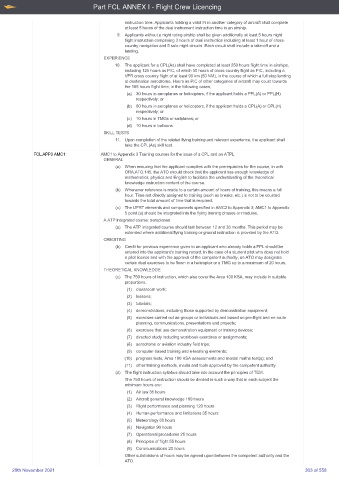Page 303 - UK Aircrew Regulations (Consolidated) 201121
P. 303
Part FCL ANNEX I - Flight Crew Licencing
instruction time. Applicants holding a valid IR in another category of aircraft shall complete
at least 5 hours of the dual instrument instruction time in an airship.
9. Applicants without a night rating airship shall be given additionally at least 5 hours night
flight instruction comprising 3 hours of dual instruction including at least 1 hour of cross-
country navigation and 5 solo night circuits. Each circuit shall include a take-off and a
landing.
EXPERIENCE
10. The applicant for a CPL(As) shall have completed at least 250 hours flight time in airships,
including 125 hours as PIC, of which 50 hours of cross-country flight as PIC, including a
VFR cross country flight of at least 90 km (50 NM), in the course of which a full stop landing
at destination aerodrome. Hours as PIC of other categories of aircraft may count towards
the 185 hours flight time, in the following cases;
(a) 30 hours in aeroplanes or helicopters, if the applicant holds a PPL(A) or PPL(H)
respectively; or
(b) 60 hours in aeroplanes or helicopters, if the applicant holds a CPL(A) or CPL(H)
respectively; or
(c) 10 hours in TMGs or sailplanes; or
(d) 10 hours in balloons.
SKILL TESTS
11. Upon completion of the related flying training and relevant experience, the applicant shall
take the CPL(As) skill test.
FCL.APP3 AMC1 AMC1 to Appendix 3 Training courses for the issue of a CPL and an ATPL
GENERAL
(a) When ensuring that the applicant complies with the prerequisites for the course, in with
ORA.ATO.145, the ATO should check that the applicant has enough knowledge of
mathematics, physics and English to facilitate the understanding of the theoretical
knowledge instruction content of the course.
(b) Whenever reference is made to a certain amount of hours of training, this means a full
hour. Time not directly assigned to training (such as breaks, etc.) is not to be counted
towards the total amount of time that is required.
(c) The UPRT elements and components specified in AMC2 to Appendix 3; AMC1 to Appendix
5 point (a) should be integrated into the flying training phases or modules.
A ATP integrated course: aeroplanes
(a) The ATP integrated course should last between 12 and 36 months. This period may be
extended where additional flying training or ground instruction is provided by the ATO.
CREDITING
(b) Credit for previous experience given to an applicant who already holds a PPL should be
entered into the applicant’s training record. In the case of a student pilot who does not hold
a pilot licence and with the approval of the competent authority, an ATO may designate
certain dual exercises to be flown in a helicopter or a TMG up to a maximum of 20 hours.
THEORETICAL KNOWLEDGE
(c) The 750 hours of instruction, which also cover the Area 100 KSA, may include in suitable
proportions.
(1) classroom work;
(2) lessons;
(3) tutorials;
(4) demonstrations, including those supported by demonstration equipment;
(5) exercises carried out as groups or individuals and based on pre-flight and en-route
planning, communications, presentations and projects;
(6) exercises that use demonstration equipment or training devices;
(7) directed study including workbook exercises or assignments;
(8) aerodrome or aviation industry field trips;
(9) computer-based training and e-learning elements;
(10) progress tests, Area 100 KSA assessments and mental maths test(s); and
(11) other training methods, media and tools approved by the competent authority.
(d) The flight instruction syllabus should take into account the principles of TEM.
The 750 hours of instruction should be divided in such a way that in each subject the
minimum hours are:
(1) Air law 35 hours
(2) Aircraft general knowledge 100 hours
(3) Flight performance and planning 120 hours
(4) Human performance and limitations 35 hours
(5) Meteorology 60 hours
(6) Navigation 90 hours
(7) Operational procedures 25 hours
(8) Principles of flight 55 hours
(9) Communications 20 hours
Other subdivisions of hours may be agreed upon between the competent authority and the
ATO.
20th November 2021 303 of 558

